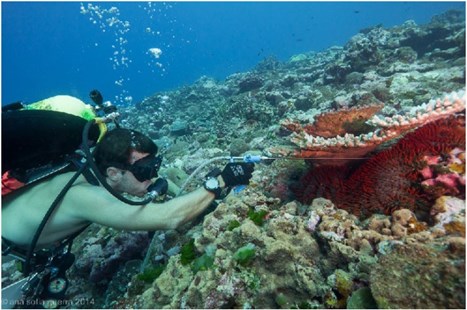Last updated: July 2, 2018
Article
National Park Service Kills Thousands of Crown of Thorns Starfish in Massive Population Control Effort

The National Park of American Samoa’s (NPSA) Marine Crew has been working to control the burgeoning population of crown of thorns seastars (COTs, Acanthaster planci, also locally known as alamea) around the island of Tutuila. Since 2013, the team has killed more than 26,000 of the venomous starfish, which eat coral polyps and can damage reefs. Due to their efforts, COT populations within the National Park have returned to normal levels.
COTs feed on coral polyps, killing the coral and leaving behind only a white skeleton. This skeleton is often quickly overgrown by algae, preventing the coral from growing back. Even if conditions are ideal, it can take up to 50 years for a coral reef to recover from COT outbreaks, with natural disturbances like cyclones making it even more difficult for the reef to recover. These reefs are vital to the island and its people, providing habitat for reef fish, protecting the shoreline from large waves and erosion, and providing a food source.

Photo Credit: Ana Guerrak, 2014, OWUSS
COTs are naturally found in American Samoa but in the last few years have been seen in alarmingly high numbers. The reason for this outbreak is thought to be due to high levels of nutrients in the nearshore waters during spawning season, which allowed a large number of COT larvae to survive to adulthood. These nutrients can come from excess fertilizer on crops, leaking septic systems, wet litter piggeries, and other sources that are transported by rainfall into the ocean. The nutrients can also enter the system through large scale disturbances such as tropical cyclones and tsunamis. It is thought that the tsunami of 2009 may have stirred up the benthic sediment, redistributing nutrient loads into the water column. These nutrients allow phytoplankton, a microscopic marine plant, to flourish. When phytoplankton levels are high, COT larvae have more food and can grow quickly, resulting in more starfish surviving to adulthood and ultimately leading to an outbreak.
The outbreak was first noticed by researchers in 2011 on the south side of Tutuila off of Taima Bank and spread to the north side of the island by 2013. NPSA began monitoring COT populations and implemented an eradication program in 2013. They found heavy outbreaks near the villages of Fagasa, Fagamalo, and Vatia.

Photo Credit: Ana Guerrak, 2014, OWUSS
In total, NPSA, with assistance from the NPS Submerged Resource Center, killed over 26,000 COTs from 2013 to 2016. This equates to saving nearly 61 football fields worth of coral! To give perspective of density, in a single day, National Park divers were able to kill 952 crown of thorns outside of the village of Fagasa. In a week, nearly 2000 COTs were killed in the same area. The COTs were killed with an injection of ox bile, which kills within 24 hours but does not harm other organisms on the reef. National Park scientists also collected important population data during eradication dives. COTs were measured underwater to collect size cohort data, which indicated the presence of a primary and secondary outbreak. A subsample were also dissected to determine spawning periods and sex ratio of the population.
The outbreak appears to have ended but NPSA is keeping an eye out for any new spikes in population, as crown of thorns outbreaks are still being reported across the Pacific. To do this, scientists towboard the north side of the island quarterly to detect new outbreak areas. In recent months, no new outbreak sites have been identified. NPSA is also working with local stakeholders to reduce sources of nutrient pollution. Ongoing research interests include bettering our understanding of outbreak dynamics and optimizing eradication efficiency by concentrating control efforts before a spawning event. These control efforts leave American Samoa’s coral reefs better equipped to deal with other environmental stressors and ensures that American Samoa will have beautiful reefs for generations to come.
Victoria Barker, American Conservation Experience, Marine Technician, National Park of American Samoa
